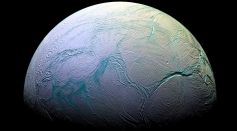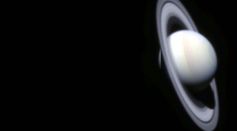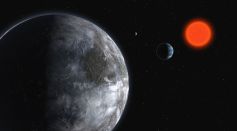Tags: Saturn
NASA Dragonfly Mission Releases Science Goals and Objectives on Saturn's Moon Titan

Jupiter, Saturn Opposition 2021: How to Watch Giant Planets Glow
Moon-Forming Disk Captured Around Exoplanets Resembling Saturn and Jupiter; PDS 70 System May Support Theories on How Planets and Moons Form

Methane Plumes on Enceladus: Could the Saturn Moon Host Life?
NASA New Mission Strategy: Get Samples from Saturn's Moon Titan to Uncover Its Mystery
Saturn's Special Magnetic Field and Helium Rain May Explain Gas Giant's Origin
Saturn’s Moon Enceladus May Have Antarctica-Like Ocean Currents

Could Saturn's Moon Titan Give Hope for Life Beyond Earth? Here's What Scientists Say

Titan Atmosphere Simulated in Research Lead by IBM: Possible Key to Knowing Origin of Earth Life

Rare Triple Conjunction: Jupiter, Saturn, Mercury Alignment This Week Won't Happen Again Until 2026!

Submarines Could Explore Largest Sea on Saturn’s Moon Titan; Can You Guess How Deep Kraken Mare Is?
What’s Causing the Tilt on Saturn’s Rotation Axis?
“Cotton-Candy” Exoplanet WASP-107b Apparently Has Less Core Mass Than Previously Thought
Google Welcomes Winter and the “Great Conjunction” with a Doodle

Christmas Star Is Not Actually a Christmas Star; Here's Why

Spectacularly Rare Planetary Alignment Is Coming This December; Here's How to Watch The Christmas Star
Every Planet In the Solar System Will Appear This Week, Even Ex-Planet Pluto

Great Conjuction 2020: Jupiter Will Align Closest With Saturn Soon! Here's What to Expect
Here's a Look At November's Stargazing Events
NASA Scientists Found An Unexpected Molecule in Atmosphere of Saturn’s Largest Moon
Most Popular

Texas Official Shot Down Siren Flood Alert, Complaining That It Might Go Off 'In the Middle of the Night': Report

Nvidia's Jetson Thor Could Make Humanoids Smarter Than Ever

Trump's Trillion Dollar Spending Boost For Pentagon to Create Disastrous Amount of Carbon Emissions, Study Shows

How Gene Editing Could Save Endangered Species from Extinction




